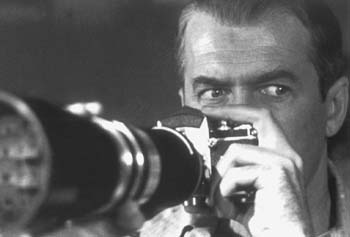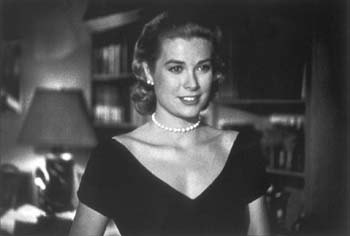![[Metroactive Movies]](http://metroactive.com/movies/gifs/movies468.gif)
[ Movies Index | San Jose | Metroactive Central | Archives ]
Looks Can Kill
Be careful what you watch for in Alfred Hitchcock's 'Rear Window'
By Richard von Busack
WHEN ALFRED Hitchcock's devastating classic Rear Window was released in 1954, it was greeted as the perfect trifle. As was said of Max Ophuls' films, it's superficially superficial. Rear Window, now being rereleased in a beautifully restored print, tells the story of an affable voyeur, a news photographer named L.B. Jefferies (James Stewart).
Laid up in a wheelchair in his studio apartment, recovering from a broken leg, Jefferies spies on his Manhattan neighbors across a courtyard. The action, confined entirely to that courtyard, takes place during a heat wave, when the neighbors' windows are open and their lives are revealed to him. One day, he sees evidence in a neighboring apartment that a husband has murdered his wife.
Rear Window's boundlessly clever techniques mirror the same mystery that a good film provides, and it comes to a terrifically simple point: In an instant, Jefferies is transformed from a watcher to a watched, the focus of all eyes in his courtyard. And the moral, according to Jefferies' nurse, Stella, played by the all-wise Thelma Ritter, is "Someday, you'll see something out the window that'll get you into trouble." It's a caution every moviegoer ought to heed.
All a trifle--or it would be in the hands of any director less troubling than Hitchcock. This gorgeous thriller boasts a strong subplot about a man who has had one leg in a trap for weeks and is anxious not to get the other one caught. Jefferies is under pressure to marry his affluent girlfriend, Lisa (Grace Kelly).
Wordlessly, Hitchcock relates the back-story of how Jefferies broke his leg--by casting his lens over a few framed photographs. We see that Jefferies is a man who has photographed wars and auto races; we see that he's being urged into marrying Lisa and starting a new career as a society photographer.
As a sort of joke, Jefferies has framed the negative of a glamour photo of Lisa. She has white pupils and black teeth--it's a portrait as romantic as a jack-o'-lantern. As he tries to hold the insistent Lisa back, Jefferies watches a pageant of men and women through the windows of the other apartments. ("Everything [Jefferies] sees across the way has a bearing on love and marriage," Hitchcock explained to his interviewer François Truffaut.)
In one window is the promise of easy sex, as displayed by a half-naked dancer Jefferies names "Miss Torso." Jefferies also spies on the lives of a lonely man and a lonely woman in two different apartments, one turning to drink and the other on the verge of suicide. And there's a newlywed couple having a honeymoon in a third. All the scenes are played out for Jefferies as a reflection of his thoughts and fears about settling down.
And lastly, in the Thorwald apartment, Jefferies sees the drama of the most dreadful end a marriage can take.
JOHN MICHAEL HAYES' screenplay (from a story by pulp genius Cornell Woolrich) never gets the praise it deserves. ("I thought the rain would cool things down--all it did was make the heat wet.") Despite Stella's warning, the script endorses the practice of getting an eyeful, which is something I hadn't remembered. When Stella proclaims, "We've become a nation of voyeurs," Jefferies cuts the crap by locating the citation: "Reader's Digest, April 1939").
Raymond Burr was never better than he was as hulking Lars Thorwald--no diabolical killer but a shabby, depressed man with gold-rimmed spectacles, a cardboard valise and a voice crumbling under the stress of Lisa's and Jefferies' taunting.
And note the growing peevishness Stewart displays as a man who has been watching too much. In the restored version, the color has been renewed to bring out the pastels and the color orange--a tough color to get right in a movie. Orange is the lurid color of a Manhattan sky in summer here and also the color of the atomic bursts of the camera flashbulb. Also brought back from the original, through some kind of computer augmentation, is a startling kiss set to a different tempo than the rest of the symphony.
And the older you get, the better Hitchcock's films look. What dignity Hitchcock gives middle-aged angst--here as in Vertigo, which begins where Rear Window ends, with Stewart dangling over the abyss.
[ San Jose | Metroactive Central | Archives ]
Copyright © 1999 Metro Publishing Inc. Metroactive is affiliated with the Boulevards Network.
For more information about the San Jose/Silicon Valley area, visit sanjose.com.
![]()

See or Be Seen: Jimmy Stewart in 'Rear Window' is proof that good shades make good neighbors.

That Persistent Object of Desire: Grace Kelly is James Stewart's co-peeper in 'Rear Window.'
Rear Window (Unrated; 112 min.), directed by Alfred Hitchcock, written by John Michael Hayes, based on a story by Cornell Woolrich, photographed by Robert Burks and starring Jimmy Stewart, Grace Kelly, Thelma Ritter and Raymond Burr, opens Friday at the Camera One in San Jose.
From the February 17-23, 2000 issue of Metro, Silicon Valley's Weekly Newspaper.